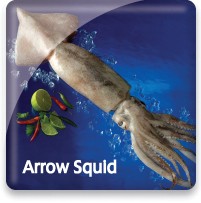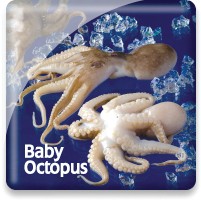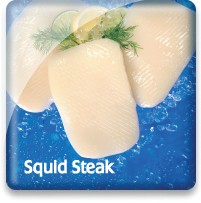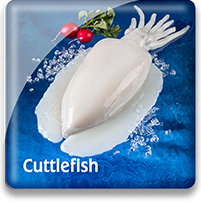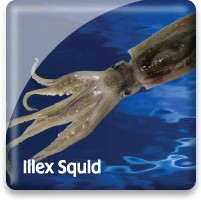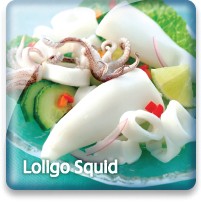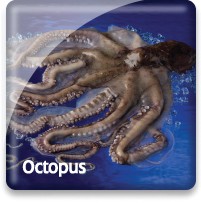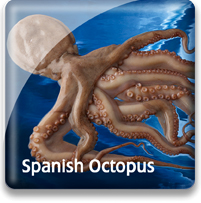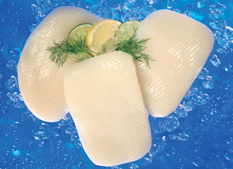
Calamari Squid Steaks

Market Name: Eating QualitiesCalamari Squid Steak is a versatile product that is not strongly flavored, but considered by many to possess a kind of sweetness. The meat is tender and succulent. Frozen tubes should be ivory-white throughout and have no distinct odor.
When chased, many squid squirt a dark liquid (referred to as ink) to distract their attackers.
|
Description & CharacteristicsCalamari Squid Steaks are a wonderfully healthy high-protein, premium quality, low-cost seafood. Squid Steaks are also known by their Japanese name Marasaki Ika. Sea Port’s Taiwan Calamari Steaks are produced exclusively year round by Taiwan’s premier packers into four to five-ounce steaks. Sea Port has recently started offering Calamari Squid Steaks from Peru that use a different species, Dosidicus gigas (Humboldt Squid). The tenderized, oval-shaped steaks are often prepared Japanese-style, egg battered with panko flakes; served simply grilled or sautéed; or cut into stripes for gourmet seafood salads.Squid, also called calamari, is a cephalopod mollusk with eight arms, two tentacles and a tubular shaped body that narrows to a point and has two fleshy wings along the rear part of the body. Squid swim tail-first by pumping water through valves located near their head. The shells have evolved into a small bone or pen inside the body. Like octopus and cuttlefish, they are cephalopods. There are many species in all seas, ranging in length from one inch to the Chilean giant squid of six feet and one hundred pounds. Even larger monsters are thought to live in very deep water. Squid grow fast and live only 12 to 14 months. Squid has a good shelf life if handled with reasonable care. It is little affected by freezing, and the texture is unchanged even if the flesh is frozen and thawed a number of times. Fresh squid should have a sweet smell. It becomes rather pungent with age. Skin spots and color are not reliable guides to quality.The tentacles, wings and mantle (body) are all edible. There is a thin, soft skin covering the body and wings, which is usually removed before cooking. The skin changes color dramatically after the squid is caught. This is a natural process and is not a symptom of decomposition. Squid may be “bleached” by soaking it in iced water. This reduces the color changes and whitens the skin. Squid is processed into tubes, rings and strips. Steaks, circular pieces cut from the mantles of large squid and usually tenderized with a needle machine, are also produced as a retail trade alternative to expensive abalone steaks. Fried calamari has become a mainstay on many restaurant menus, which has contributed to an explosion in domestic usage. A great deal of squid is frozen whole for bait, used by both sport fishermen and commercial line fishermen.
Currently Sea Port utilizes two squid species for their Squid Steaks; Ommastrephes bartramii and Dosidicus gigas.
Other ResourcesMarine Resource Fact Sheet |
Handling Instructions for Calamari Squid Steak
Calamari steaks should be stored frozen at 0°F (-18°C) and then thawed properly when ready to cook. Calamari steaks should be Stored in the freezer in the original package or in plastic wrap or a sealed plastic bag for product that has been removed from the original packaging. This will help prevent freezer burn (dehydration). Generally it is best to consume commercially frozen squid within 12 months for IQF product and at the most 18 months for block frozen squid from the freeze date. Our Calamari steaks are best consumed within 12 months from the freeze date. Links to obtain further information concerning the proper handling of squid and other seafood: NOAA - Fish Watch: Handling Seafood and A Consumer Guide to Safe Seafood Handling.
Thawing Calamari Squid Steak
Calamari steaks can be thawed under refrigeration between 35 and 40°F (1.7 to 4 degrees C) and usually become thawed within 12-24 hours. However, for quicker thawing we suggest placing the steaks in a plastic bag or wrap and running them under cold water until thawed. For even quicker preparation, run the steaks under cold water and then cook them from the partially frozen state.
Important Instructions for Calamari Squid Steak
Upon thawing calamari steaks, gently rinse with cold clean water. Thawed calamari steaks should be used immediately or temporarily stored under refrigeration (35-40°F) and consumed within 24-48 hours due to the fact that squid in general has a relatively short thawed refrigerated shelf life.
Cooking Tips
Most calamari steaks should be cooked rather quickly to avoid becoming rubbery in texture. However, our steaks are pre-tenderized and will remain tender even when subjected to longer cooking times. Our calamari steaks are the most versatile of all our squid products due to their ability to maintain quality throughout various cooking schemes ranging from high temperature stir fry to the slower cooking soups and casseroles. Link to obtain further information concerning cooking tips for squid.
Taiwan
The island of Tawian, shaped like a tobacco leaf, nation, is located off the coast of China where it is officially part of the Republic of China. Some 23 million people live in an area that is just 245 miles long and 89.5 miles wide, making Taiwan the second-most densely populated country in the world.
While it offers few opportunities for recreational fishing, Taiwan’s commercial fishing industry is well-established, with a fleet of vessels that fish around the world for tuna, sharks, herring, reef fish, horse mackerel, sardines, squid and octopus. Aquaculture is also an important new industry in Tawian, with freshwater farms growing shrimp farms, and tilapia, and marine farms growing shellfish such as clams and oysters.
China
With more than 1.3 billion people, China is today the world’s most populous country. With a growing economy fueling an appetite for seafood, China has begun importing seafood for in-country consumption, as well as exporting a great deal of its production. In fact, since 2002, China has continued to export more fish and fishery products than any other country in the world, with Japan, the United States, and the Republic of Korea as its main export markets.
Chinese distant water fishing activities started in 1985 when China gained access to new fishing grounds through agreements with foreign countries. China operates vessels in West Africa, the North Pacific, and tuna longline vessels in the South Pacific. In addition, squid are harvested in the Japan Sea, the South Atlantic, and the North Pacific under Chinese-flagged vessels.
Carp are also commercially important, as are bream, shad, eel, catfish, rainbow trout, salmon, whitebait, mullet, mandarin fish, perch, sturgeon, and murrel (snakehead). Commercial shellfish include Saltwater & freshwater shrimp, river crabs, and mollusks such as mussels, clams, oysters, and freshwater snails.
With one-fifth of the world’s population, and an official government policy to promote aquaculture, China has today become an aquaculture powerhouse, now producing more than two-thirds of the world’s aquaculture species. Fish and shellfish are grown in freshwater and saltwater environments.
Korea
The Republic of Korea (South Korea) is comprised of a main peninsula and over 3000 small islands that have a combined coastline of over 15,000 miles. Wild fisheries have historically been the dominant production method for seafood and today represents roughly 70% of their total production. As Korea’s wild fisheries production declined during the past 15 years, the Korean government initiated efforts to develop and expand aquaculture to help fill the shortfall. At present, aquaculture provides the remaining 30% of Korea’s seafood production and consists of mainly seaweed, shellfish, and finfish. Korea ranks number 14th in world aquaculture production. Sustainable aquaculture development is promoted and managed by the Korean Ministry of Maritime Affairs and Fisheries. The ministry’s goal is to create a profitable export market for Korea’s growing aquaculture industry.
Go Blue! Seafood Sustainability Spectrum*Click here for an explanation of our Sustainability Spectrum 
Sustainability AssessmentSea Port’s Squid Steaks are processed from the North Pacific Flying Squid (Ommastrephes bartramii) and the Humboldt Squid (Dosidicus gigas). These two large squid species have similar life histories and are both harvested by jigging. Because most squid species have relatively short life spans and grow to reproductive age quickly, their populations are thought to be somewhat resilient to moderate levels of fishing pressure. The short life span and unpredictable nature of factors such as egg survival and the influence of environmental conditions make it difficult to assess squid populations using conventional stock assessment methods. In many cases, effective management of squid fisheries is lacking. Additionally, certain squid fisheries also carry a risk of severe habitat impacts from the fishing gear used (e.g., bottom trawling on sensitive habitats such as cobble and coral). Sea Port’s squid are primarily harvested by jigging which results in little by-catch or destruction to sensitive habitats. Improvements in data collection and management are necessary to mitigate the risk of negatively impacting populations through overharvesting, particularly in light of the fact that recent declines in “traditional” fish stocks have fueled increased interest in squid fisheries worldwide.
Environmental Impact: Moderate to HighBecause population fluctuations seem to be closely tied with environmental factors, year to year squid biomass is difficult to accurately predict. Management of the resource is inadequate in many major squid fisheries. Additionally, some squid are caught by bottom trawling, which can negatively impact ocean floor habitats.
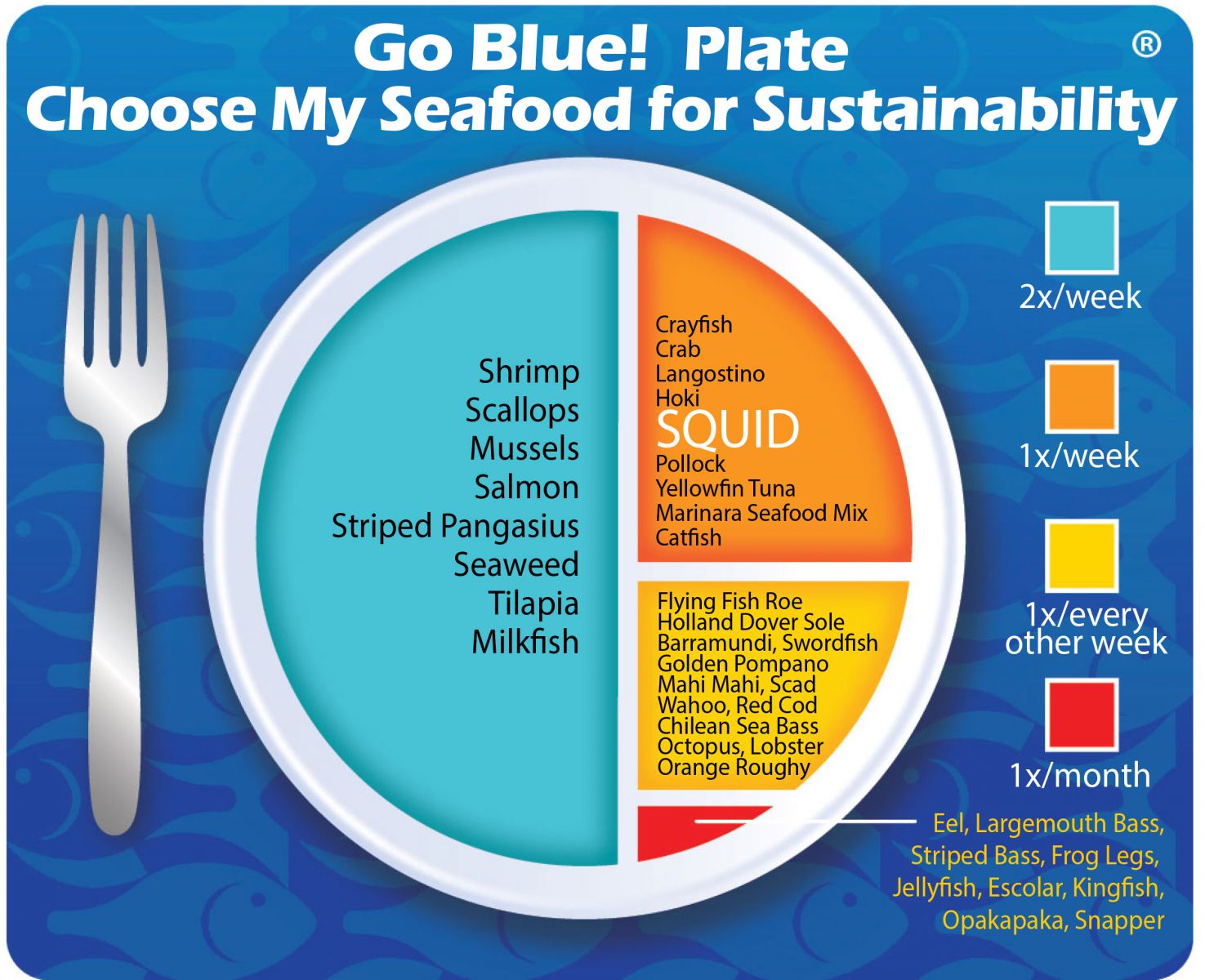
Sustainability Improvements NeededImprovements in the amount and types of data collected are needed in order to accurately establish fisheries trends and further develop stock assessment models specific to squid. Specific management measures for squid also need to be developed in many fisheries in order to prevent overfishing. Research into mitigation of habitat impacts by bottom trawling (e.g., gear modifications) is also needed.
Actions that Sea Port is UndertakingSea Port is requiring that their suppliers provide fishing vessel identification, catch methodology, and catch area information. In doing so, Sea Port hopes to encourage the squid fishery to collect additional critical catch and resource data where none currently exist. This increased availability of data will allow for fishery management schemes to be establish or improved upon to assure the sustainability of the squid fishery. Sea Port believes that jigging for squid (the method Sea Port’s suppliers primarily use) impacts the marine ecosystem less than industrial trawling. Sea Port also believes that, in aggregate, choosing from a diverse variety of seafood is better for sustaining the world’s seafood resources and squid should be a part of this diverse variety. We created the sustainability assessments for each of our seafood items in order to reveal the existing and potential environmental impacts and risks that are associated with producing them for human consumption. This allowed us to establish the starting position for each of our seafood items along our progressive Go Blue! Seafood Sustainability Spectrum®. These assessments are only a single snapshot in time and because of this, we will continue to assess and update the critical sustainability needs associated with our supply sources and issue updates to the Go Blue! Seafood Sustainability Spectrum® as needed. There is a growing global awareness for the need to assure the sustainability of farmed and wild caught seafood and because of this; all around the world positive changes are rapidly occurring at all levels of the seafood supply chain. We will continue to spread this growing awareness and work with our many industry partners to improve the sustainability of all seafood, which we believe is the ideal protein of choice to feed an ever growing world population. Our Go Blue! Seafood Sustainability Spectrum® serves as our compass and yardstick as we strive to move all our products forward to becoming more sustainable. Please join us in this committed quest and Catch Our Wave® to sustainability by choosing a diverse variety of responsibly produced seafood as part of your diet.
|


